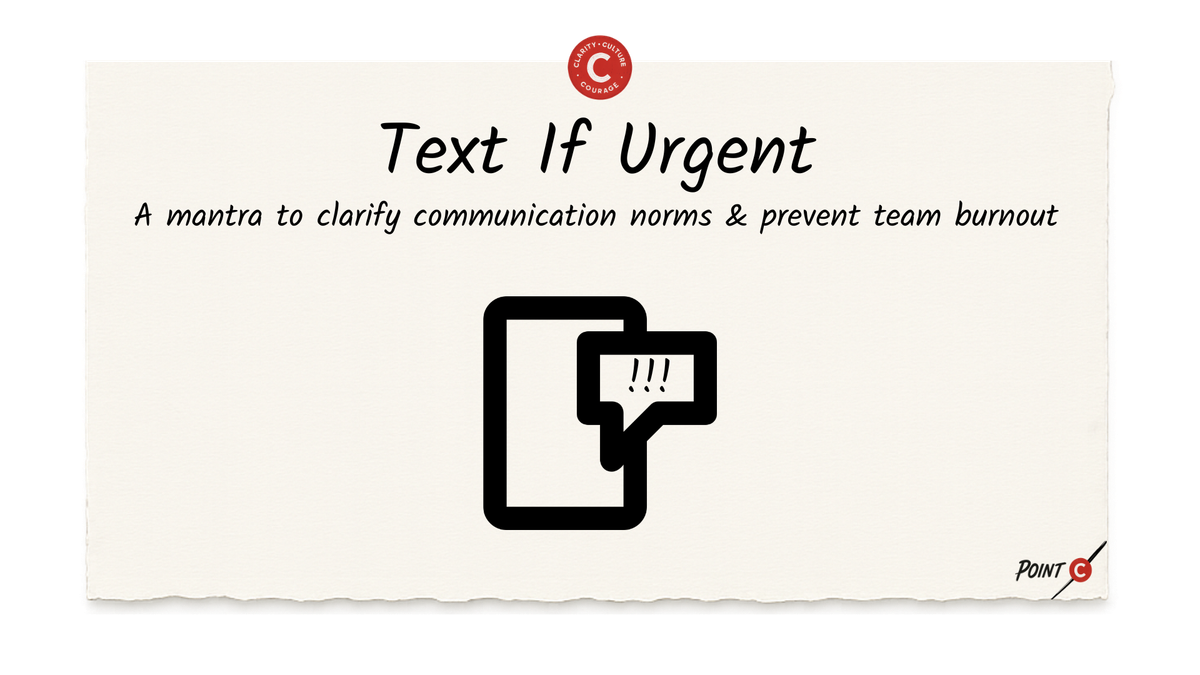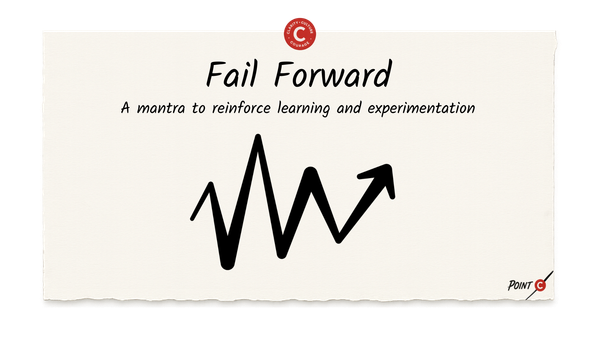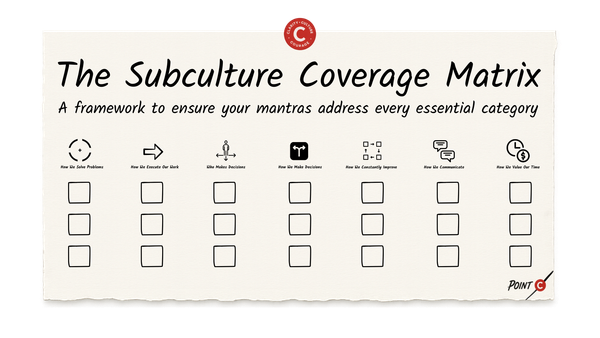Text If Urgent
A mantra to clarify communication norms & prevent team burnout

In The Idea Bucket, I'm focused on giving you one framework per week that can take you one step closer to building a subculture of innovation. We're now covering the seven essential categories of norms that you need to reinforce with at least one leadership mantra to build a high-performing innovation team:
- How We Solve Problems
- How We Execute Our Work (Fail Forward)
- Who Makes Decisions (One Consultative Decision Maker Per Lane)
- How We Make Decisions (Always Separate Flaring & Focusing)
- How We Constantly Improve (Feedback is a Gift - Not a Demand)
- How We Communicate
- How We Value Our Time (Honor The Maker's Schedule)
Today we'll dive into my go-to mantra for How We Communicate: Text If Urgent
It's a mantra that very well might save your team from burnout.
Match The Medium To The Mantra
As we've discussed, high-performing innovation teams need to take the time up front to agree on explicit rules for how they will operate. How We Communicate is an essential norm you need to get clear about right from the beginning. Because if you don't have clarity on communication, you'll lead your team right into unnecessary conflict.
And by communication norms, I don't just mean the mediums (email, Slack, text, phone) we'll use to communicate, but also the different expectations that are implied when you receive a message via each of those mediums.
Because if you don't clarify what receiving a message in a particular medium means for your employees, I guarantee the default message will be this:
Everything is urgent. You must be responsive at all times. You must constantly check email and Slack, even on weeknights and weekends. You cannot shut it off.
That's a leadership mistake. I know because I learned this lesson the hard way.
How I Learned This The Hard Way
I was in my second year of getting my start-up accelerator, Matter Ventures, off the ground when my key employee who was the glue holding all the operations together told me she was quitting. She loved her job but she was totally burnt out. She was constantly working nights and weekends and had started having nightmares punctuated by Slack notifications. She had been unable to establish effective boundaries for herself between work and personal life - and I hadn't helped.
As a founder trying to scrape together this start-up with limited resources and limited time, I too was struggling to find work-life balance. I would be in meetings all day (this was before I began to Honor The Maker's Schedule) and the only time I could clear my ever-growing email and Slack inbox was on nights and weekends. Early morning was the only time I could do deep creative work. As a result, I was sending emails and Slack messages during times when I expected my employees to be resting and enjoying their lives. Now, when I was sending those messages, I really wasn't expecting that my employees would be reading and responding until the next business day. But they didn't know that. I hadn't been explicit about what it meant when I sent a message over certain mediums.
That’s how my bad habits started infecting the team.
Fortunately, this conversation with this employee who was about to quit was a huge wake-up call. We were able to have an open conversation about what her perceptions were around my communication and what my intentions were and we discovered a big gap.
A gap that we successfully filled with this mantra: Text If Urgent
Break the Always-Urgent Mentality
Text If Urgent proactively breaks the default norm of Everything Is Urgent in the mind of your team. And it also forces a differentiation of norms between different communication mediums. Here's what it meant to my team in more detail:
First, we listed out each of our communication mediums and defined what we would use each medium for and what the expected response time would be:
1) Slack Internally: Slack is our primary internal communication medium. When talking to internal colleagues, all communication happens via Slack. You are expected to respond to Slack messages within one business day (assuming you are not currently in a back-and-forth dialogue). You can send a Slack message at any time, day or night, and that does NOT signal an expectation of an immediate reply. That way you can get work done whenever it works best for you without forcing others to work on your schedule.
2) Email Externally: Email is a secondary form of communication. It is our primary method for communicating with the outside world. Use email for outside communication, including when you need to loop in other colleagues with an external person. Do not send emails for purely internal communication. You are expected to respond to email messages within one business day. You can send an email at any time, day or night, and that does not signal an expectation of an immediate reply.
3) Text If Urgent: Text is how we signal to a colleague that something is urgent. We only use texting for this purpose. We keep the channel clear for only urgent matters. We expect everyone to be reachable via text after hours and on the weekend in the rare case that something urgent comes up. That way they can comfortably disconnect from all other mediums. If you send a text, you must be able to justify why it is worth interrupting someone's personal time. Sending a text should be rare.
These are the norms that worked best for my team. And they've worked incredibly well to protect their mental health and reduce conflict while allowing them to execute when they need to.
Do you need to follow these exact norms? No. They can — and should — change based on your particular context. But any communication norms should follow this rule:
Be explicit about the different communication mediums you use. Have a purpose for each medium. Have a hierarchy of mediums. And have one separate medium that is only used to signal urgency.
What This Unlocks
It may seem simple, but this type of clarity unlocks all sorts of benefits for your team and your culture, including:
- The Ability To Focus: As I discussed in Honor The Maker's Schedule, we all need half-day stretches of uninterrupted focus time to do deep work. This mantra enables your teammates to turn off the Slack and Inbox Zero moment-to-moment distractions and do that deep work you need them to do. You can always reach them via text if it is truly urgent.
- The Ability To Recharge: As you can see for my personal example, without giving people the explicit permission to disconnect from work, they won't. And while that may seem like a productivity win for you in the short-term, it will lead to a culture of burnout in the long term. (And if you find yourself saying "Well, I suffered through it with my boss so they should too." I need you to recognize that true leadership means being the first to break these vicious cycles.)
- The Ability To Work When You Need To: Sometimes you need to work nights and weekends. It's not ideal but I do believe that your norms should allow for this choice. Some people try to solve this by scheduling emails to be sent later. While that's thoughtful, I think it's more powerful to explicitly state the value and norm of protecting people's time rather than having it be at the mercy of one scheduled-send workaround at a time.
- The Reduction of Conflict: This level of specificity ultimately reduces conflict. We don't have to read between the lines of what receiving an email on the weekend means. We know what it means because we've talked about it. The more we anticipate up-front, the less conflict we'll have as a team.
Small, explicit changes. Big cultural unlocks.
Your Challenge This Week
Audit the communication norms of your team:
1) Forward this email to your team to set the context.
2) Ask each of your leaders to name the implicit assumptions they have about each communication medium:
- What are their assumptions when you send them an email, a Slack message, or a text?
- What are their expectations when they send an email, a Slack message, or a text to their team members?
- Do the expectations change based on the hierarchy of the relationship?
- How do the expectations change after-hours or over the weekend?
- Are they able to disconnect both digitally and mentally on a regular basis?
- How do they signal that something is urgent?
3) Come together as an executive team to share stories and distill insights.
4) Decide if there are some explicit communication norms that need to be established and communicated throughout the company.
Once your norms are clear, the mental load on your team drops — and performance goes up.
Next Week
We've now got one mantra in six of the seven essential categories:
- How We Solve Problems
- How We Execute Our Work (Fail Forward)
- Who Makes Decisions (One Consultative Decision Maker Per Lane)
- How We Make Decisions (Always Separate Flaring & Focusing)
- How We Constantly Improve (Feedback is a Gift - Not a Demand)
- How We Communicate (Text If Urgent)
- How We Value Our Time (Honor The Maker's Schedule)
Next week, we'll dive into the most fundamental mantra for How We Solve Problems: Let The User Decide
About This Newsletter
The Idea Bucket is a weekly newsletter and archive featuring one visual framework, supporting one act of leadership, that brings you one step closer to building a culture of innovation.
It’s written by Corey Ford — executive coach, strategic advisor, and founder of Point C, where he helps founders, CEOs, and executives clarify their visions, lead cultures of innovation, and navigate their next leadership chapters.
Want to explore how strategy and storytelling come together? Check out The Venture Story — my first mini-book and leadership storytelling framework.
Want to give your teams an immersive learning experience on these concepts? Bring me in to run The Point C Training Camp at our company.
Want 1:1 executive coaching on this framework or others? Book your first coaching session. It's on me.




